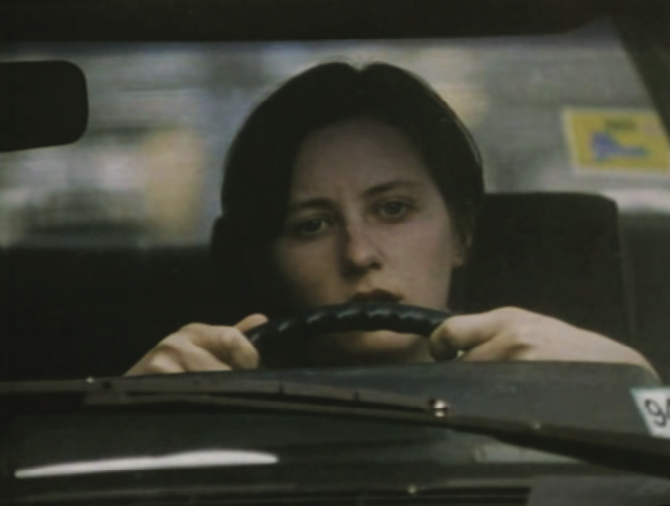“Are we going to have to kill him?” “I hope not here.” The dialogues in Chris Kraus’s films, such as this exchange from Sadness at Leaving (1992) – an adaptation of Erje Ayden’s pulp spy novel from 1989 – are piercing. The acting is heightened in a way that makes the characters feel slightly off. Self-conscious and often self- deprecating awkwardness is a key ingredient in Kraus’s writing and her moving-image oeuvre, evoked in the latter by alienated dramaturgy, theatrical sound effects and harsh cuts.
At Index, all nine films that Kraus made, between 1982 and 95, are on view. Like the writing in her art-theory-injected novels, the movies sway from documentary to essay lm to footage of performances, the last of these made with collaborators in the New York art scene before Kraus moved to Los Angeles. Each loops on a monitor, propped on a large wooden platform installed at knee height in the centre of the space. Most of the films are between 5 and 30 minutes long: for instance, How to Shoot a Crime (1987), which Kraus made with her ex-husband, Sylvère Lotringer, who infamously features in her novel I Love Dick (1997), and which includes interviews with the dominatrix Mademoiselle Victoire and the artist Brian Weil, who notoriously documented homicide scenes in Miami. The film discusses violence, death, desire and the role of the spectator, both in person and through technologies increasingly deployed for surveillance. In Traveling at Night (1991), Kraus joins a group of elementary-school children on a fieldtrip as they learn about the Underground Railroad. Then there’s the feature-length Gravity & Grace (1996), titled after Simone Weil’s compendium of writings. The movie centres on two young women who are involved in a cult in New Zealand, following one of them as she leaves to ‘make it’ in the New York artworld (and eventually fails). The ascetic install is in stark contrast to the content of the films: they speak unabashedly about sex, gender dynamics and politics.
Installed on wall-mounted shelves are seven of Kraus’s books, and next to them is an enlarged printout of a page from each in which she refers to her filmmaking. In Aliens & Anorexia (2000), for example, Kraus discusses what she saw as the failure of Gravity & Grace, which was rejected several times at the Berlin Film Festival and never attained the success for which she had hoped. The display points to her practice of moving between writing and filmmaking, between theory and practice, the whole imbued with autobiographical experience and wider feminist concerns.
The austere exhibition display, meanwhile, with its sparse editorialising, equates to a gesture of merely making the films available to the public (although most of them are also online on UbuWeb), perhaps trying to grant them the attention Kraus bemoans that they never received. Considering that she refers to her films as failures, the show seems more like an archival attestation of their existence than an attempt at curatorial unpacking. FILMS BEFORE AND AFTER, then, relies on the enigma surrounding Kraus as a cultural icon in order to let the works speak for themselves, years and decades after their making. As an archive, it works. As an exhibition, it leaves us longing for more.
Chris Kraus: FILMS BEFORE AND AFTER, Index – The Swedish Contemporary Art Foundation, Stockholm, 1 June – 13 October 2019
From the October 2019 issue of ArtReview
